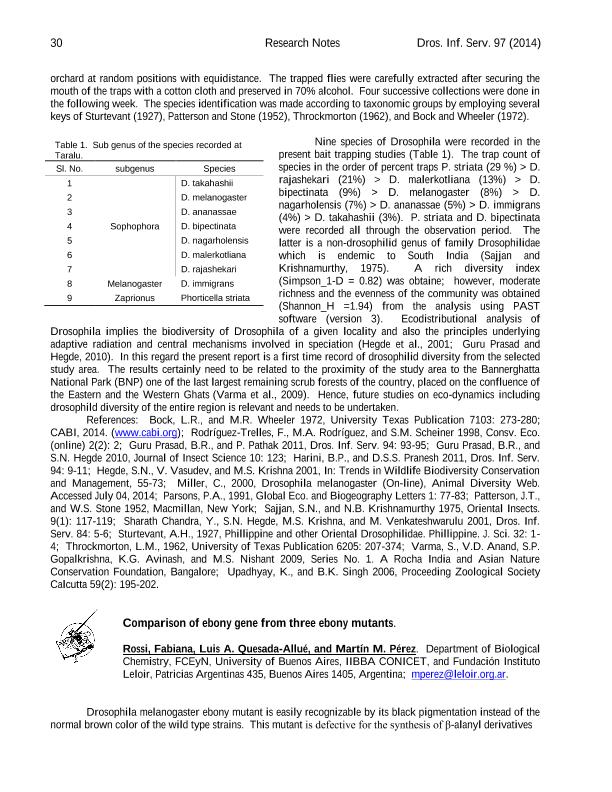Mostrar el registro sencillo del ítem
dc.contributor.author
Pérez, Martín Mariano

dc.contributor.author
Rossi, Fabiana Alejandra

dc.contributor.author
Quesada Allue, Luis Alberto

dc.date.available
2016-11-29T21:24:39Z
dc.date.issued
2014-12
dc.identifier.citation
Pérez, Martín Mariano; Rossi, Fabiana Alejandra; Quesada Allue, Luis Alberto; Comparison of ebony gene from three ebony mutants; University of Oklahoma; Drosophila Information Service; 97; 12-2014; 30-32
dc.identifier.issn
0070-7333
dc.identifier.uri
http://hdl.handle.net/11336/8481
dc.description.abstract
Drosophila melanogaster ebony mutant is easily recognizable by its black pigmentation instead of the normal brown color of the wild type strains. This mutant is defective for the synthesis of β-alanyl derivatives such as N-β-alanyldopamine (NBAD) or N-β-alanylhistamine (carcinine), which are the products of the conjugation of β- alanine with dopamine or histamine respectively. Besides body color defect, other wellknown features of this mutant are the neurological and behavioral disorders, such as abnormal electroretinograms, lacking “on” and “off” transients (Hotta and Benzer, 1969), reduced phototaxis (Benzer, 1967) and abnormal circadian rhythm (Newby and Jackson 1991). For many years, Ebony was known as an epidermal enzyme responsible only for tanning and sclerotization of brown cuticles (Wright, 1987). We previously demonstrated that NBAD-synthase is an enzyme induced in epidermis with a narrow window of expression at the beginning of pupariation (Pérez et al., 2002; Wappner et al., 1996a). The enzyme is also induced during the transition from pharate adult to imago and during the first hours after the ecdysis (Pérez et al, 2004: Pérez et al., 2010). Recently, we documented the expression of NBAD-synthase in epidermal tissues of D. melanogaster embryos (Pérez et al., 2010). In addition to the expression of NBAD-synthase in epidermis, we found that this activity is also expressed constitutively in nervous system (Pérez et al., 2004), suggesting a role in the metabolism of neurotransmitters. Furthermore, it has been postulated that this enzyme functions in a metabolic pathway that may terminate the action of histamine in photoreceptor cells (Borycz et al., 2002; Richardt et al., 2003). Our biochemical and immunohistochemical results demonstrated that NBAD-synthase is widely expressed in the brain. Thus the expression of Ebony in brain regions other than retinas suggests that this enzyme not only plays a role in the metabolism of histamine in visual system but also in the metabolism of other neurotransmitters like dopamine and possibly octopamine and serotonin (Pérez et al., 2002; Richardt et al., 2003; Pérez et al, 2004). We previously analyzed NBAD-synthase in vitro activity in the ebony mutants e1 and e4 and we found that they are unable to synthesize β-alanyderivatives (Pérez et al 1997; 2001). We have also cloned and sequenced the e4 mutant gene, showing that it has a 447 base pairs deletion in its first exon, synthesizing a protein without activity due to the lacking of 149 aminoacids (Pérez et al., 2001). Some slight physiological differences exist among the different ebony mutants, with e4 being the less drastic phenotype (Newby and Jackson, 1991; Rossi et al, data not shown; Flybase). To address the reason of this discrepancy we characterized molecularly e1 and e11 to better understand their phenotypes...
dc.format
application/pdf
dc.language.iso
eng
dc.publisher
University of Oklahoma
dc.rights
info:eu-repo/semantics/openAccess
dc.rights.uri
https://creativecommons.org/licenses/by-nc-sa/2.5/ar/
dc.subject
Ebony
dc.subject
Nbad-Synthase
dc.subject
Coding Sequence
dc.subject
Alleles
dc.subject.classification
Bioquímica y Biología Molecular

dc.subject.classification
Ciencias Biológicas

dc.subject.classification
CIENCIAS NATURALES Y EXACTAS

dc.title
Comparison of ebony gene from three ebony mutants
dc.type
info:eu-repo/semantics/article
dc.type
info:ar-repo/semantics/artículo
dc.type
info:eu-repo/semantics/publishedVersion
dc.date.updated
2016-11-29T12:42:36Z
dc.journal.volume
97
dc.journal.pagination
30-32
dc.journal.pais
Estados Unidos

dc.journal.ciudad
Oklahoma
dc.description.fil
Fil: Pérez, Martín Mariano. Consejo Nacional de Investigaciones Científicas y Técnicas. Oficina de Coordinación Administrativa Parque Centenario. Instituto de Investigaciones Bioquimicas de Buenos Aires; Argentina. Fundación Instituto Leloir; Argentina. Universidad de Buenos Aires. Facultad de Ciencias Exactas y Naturales. Departamento de Química Biológica; Argentina
dc.description.fil
Fil: Rossi, Fabiana Alejandra. Universidad de Buenos Aires. Facultad de Ciencias Exactas y Naturales. Departamento de Química Biológica; Argentina. Consejo Nacional de Investigaciones Científicas y Técnicas. Oficina de Coordinación Administrativa Parque Centenario. Instituto de Investigaciones Bioquimicas de Buenos Aires; Argentina. Fundación Instituto Leloir; Argentina
dc.description.fil
Fil: Quesada Allue, Luis Alberto. Consejo Nacional de Investigaciones Científicas y Técnicas. Oficina de Coordinación Administrativa Parque Centenario. Instituto de Investigaciones Bioquimicas de Buenos Aires; Argentina. Fundación Instituto Leloir; Argentina. Universidad de Buenos Aires. Facultad de Ciencias Exactas y Naturales. Departamento de Química Biológica; Argentina
dc.journal.title
Drosophila Information Service

dc.relation.alternativeid
info:eu-repo/semantics/altIdentifier/url/http://www.ou.edu/journals/dis/DIS97/Rossi%2030.pdf
Archivos asociados
